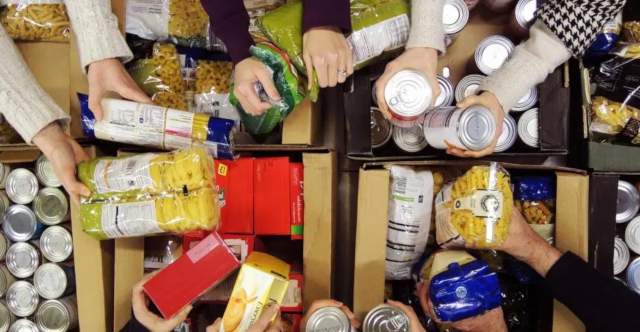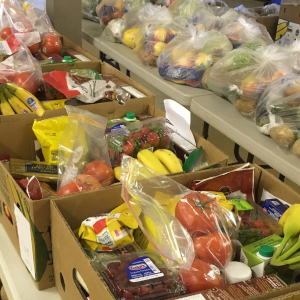A complex of global conditions is coming together to force food bank demand to record highs – even in Canada’s wealthiest province. On the eve of the first annual April Foods Day observance, a variety of organizations are calling for increased government aid…
 Packing food hampers at a local food bank…
Packing food hampers at a local food bank…
A Global News feature aired earlier this week spotlighted the plight of low-income families as the COVID situation continues, the war in Ukraine plods on, and inflation hits highs we haven’t seen in over 30 years.
“Feed Ontario is the largest collective of food banks in the province serving more than 1,200 organizations in over 130 locations. In the last year, their network served 592,000 people who made 3.6 million visits, 1 in 3 visitors is a child,” the preamble to the report reads. And that’s the situation in a nutshell. With data from more than 1,200 operations across the map, compiled over a 6-year period, the numbers are about as accurate as they can be.
Why?
Like we said, off the top: a whole mess of coinciding conditions and circumstances have produced a perfect economic storm battering low-income families from all sides. Some general considerations are affecting the whole economy:
Inflation – in general – has reached 5.7 percent, higher than we’ve seen it in the past 30 years. Food price inflation is even worse, with some products and commodities soaring 50 percent or more over previous record levels.
COVID-related issues are still causing persistent shortages of dock and warehouse workers and transport truck drivers, and…
Those Supply Chain issues are causing shortages of many food products, especially those that are out of season in northern climes. And shortages always lead to price increases.
Need for government intervention?
A new report from the University of Calgary School of Public Policy suggests that food price increases are racing ahead of incomes at the lower end of the scale, and government disability benefits. And rising rents are putting additional pressure already on strapped food budgets:
A rent increase of just $30 a month would result 375,512 more food bank visits across Ontario annually.
A $1 increase in minimum wage would lead to 187,756 fewer food bank visits a year across Ontario. Keep in mind that the minimum wage was only recently hiked to $15 an hour from around $11, and many businesses – especially restaurants and other foodservice operations – are still struggling to adapt their business models.
A $15 per month increase in Ontario Disability Support Program (ODSP) would reduce food bank visits across Ontario by 273,099 a year.
“You don’t go to a food bank as the first option,” study author Dr. Ron Kneebone said. “You’re trying to rescue yourself. You’re turning down the heat, you’re skipping meals, et cetera, and then you’re forced into a food bank.” Those at the bottom of the socioeconomic ladder, on fixed incomes, are definitely falling behind in the fight.
What we can do
As we always seem to be saying in these posts, updating you on the state of food bank demand, we can all make a difference by simply donating one or two items a week to the food bank collection boxes in our local supermarkets. And it’s equally important to donate the stuff the food banks need most. Use this list from foodbankscanada.ca as a guide:
- Whole grain foods like oatmeal, barley, high-fibre cereals or whole-grain pasta contain plenty of fibre and are an excellent source of minerals like magnesium and iron. Food banks with meal programs will use them in their kitchens to create fresh meals for their clients.
- Baby cereals and jarred baby foods make good donations since roughly one third of Canadian food bank recipients are children. “Food banks don’t like to take chances with infants, so make sure your baby food hasn’t expired before putting it in the bin,” Chris recommends.
- Lean proteins from foods like canned tuna and chicken; plant proteins like peanut butter, beans, and lentils; or more complete proteins contained in other canned meats help in the maintenance of body tissue and contribute to a feeling of satiety. Nut butters are a favourite because they’re a versatile ingredient in snacks and meals.
- Canned fruit is high in vitamin C and dietary fibre. Likewise, if they’re free of added salt and sugars, studies suggest that frozen and canned vegetables are often as good as fresh produce.
- Milk alternatives like shelf stable milk, powdered milk, almond milk, and rice milk from the grocery store shelf contain vitamin D, vitamin A, and, most importantly, calcium.
And, of course…
- Money is always welcome, to help the food banks make up shortages in donations of essential foods.
April Foods Day
Let’s all support the first annual April Foods Day observance – April 1 – helping fund food banks across Canada.
~ Maggie J.

